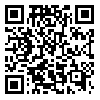BibTeX | RIS | EndNote | Medlars | ProCite | Reference Manager | RefWorks
Send citation to:
URL: http://salmandj.uswr.ac.ir/article-1-1012-en.html

 , Maryam Goudarzian
, Maryam Goudarzian 
 2, Farhad Azadi1
2, Farhad Azadi1 
 , Seyede Masoumeh Hosseini3
, Seyede Masoumeh Hosseini3 
 , Soosan Geranmayeh3
, Soosan Geranmayeh3 
 , Yasin Larni1
, Yasin Larni1 
 , Maryam Habibi1
, Maryam Habibi1 
 , Pourya Yaghmaei1
, Pourya Yaghmaei1 

2- Department of Geriatric Nursing, Iranian Research Center of Healthy Aging, Sabzevar University of Medical Sciences, Sabzevar, Iran. , mary_ac_ir@yahoo.com
3- Department of Optomtery, School of Rehabilitation Sciences, Iran University of Medical Sciences, Tehran, Iran.
Objectives: The eye refractive errors, including myopia, hyperopia, and astigmatism, are the most important visual impairments worldwide. Based on the existing evidence suggests, the visual impairment could contribute to falling in the elderly. Therefore, this study aimed to determine the influence of vision impairment of older adults with eye refractive errors on the occurrence of falls and postural control.
Methods & Materials: The older people referred to the health center of the 9th district of Tehran municipality for ophthalmic examination were examined (using ophthalmoscope and Snellen chart) by skilled ophthalmologists. Then, certain information such as their age, sex, history of special eye disease or operation, history of fall during the last 12 months, etc. was gathered through questionnaires from the older people who accepted to participate in this study after giving their informed consents. Based on eye screening results, 77 older adults with refractive errors of hyperopia (n=19, mean [SD] age=67 [5.85] y); astigmatism (n=22, mean [SD] age=70.32 [5.60] y); and both hyperopia and astigmatism (n=36, mean [SD] age=69.78 [7.69] y), as well as 23 older healthy adults, mean (SD) age=70.29(5.29) y, without any obvious eye disorders were enrolled in this study. Their history of falls and postural control were evaluated. The postural control was determined using the Timed Up and Go (TUG) test. The statistical tests were analysis of variance (ANOVA) for comparing the groups with regard to postural control and the Chi-square test for comparing the prevalence of falls between groups with refractive errors and the healthy group.
Results: The studied subjects comprised 23% (n=23) healthy ones, 19% (n=19) people with hyperopia, 22% (n=22) people with astigmatism, and 36% (n=36) people with both hyperopia and astigmatism. About 70% of them were women, and 30% were men. The results of our study showed that 15.8% of study participants with normal vision, 26.1% with hyperopia, 22.7% with astigmatism, and 38.9% with both hyperopia and astigmatism had experienced at least 2 falls in the past 12 months. The people with refractive errors showed a higher prevalence of falls; however, the result of the Chi-square test did not reveal any significant differences among these groups (P=0.25). Furthermore, the results of ANOVA for comparing TUG test (test of postural control) results showed no differences among these groups (P=0.64).
Conclusion: Vision impairment of older adults due to refractive error is not associated with an increase in falls. Furthermore, TUG test results did not show balance disorders in these groups. Further research, such as assessment of postural control with advanced devices and considering other falling risk factors is also needed to identify the predictors of falls in older adults with eye refractive errors.
Received: 2015/11/01 | Accepted: 2016/01/05 | Published: 2016/04/01
| Rights and permissions | |
 |
This work is licensed under a Creative Commons Attribution-NonCommercial 4.0 International License. |




